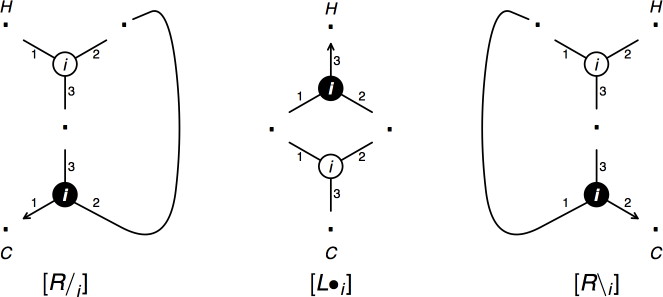Grail Tutorial - Modes
In and of itself, modes are a minor change to the basic NL formal
system. In terms of the lexical graphs, it corresponds to storing
additional information in the central circle of the connections.
Applications
An example application would be to use modes to specify the
heads of syntactic expressions. This application has been introduced by Moortgat
& Morrill (1991). For example, we can use two
modes < and > to distinguish between a
binary branch where the left daughter is the head and a binary branch
where the right daughter is the head respectively. Think of
< and > as arrows pointing towards the
head.
The figure below shows the lexical tree for the transitive verb
dismembers in both a unimodal and a multimodal version.
![[dismembers] unimodal](dismembers.jpg)
![[dismembers] multimodal](dismembers_lr.jpg)
Both trees are identical, with the exception of the mode information
in the tree on the right. The intended meaning of this tree is that the lexical leaf dismembers is the
head of this lexical item, since we arrive at this leaf following the
'arrows' indicating where the head is first to the right then to the
left.
Therefore, the verb dismembers selects a noun phrase to its
right, of which it is the head and a noun phrase to its left, the head
of which is the head of node 2, which is again the lexical leaf.
Contractions

Figure 2. A graphical representation of the binary contractions with modes
Of course, modes can be used for auxiliary graph connections as
well. The only change with respect to the contractions we've seen before is that we can only
contract two graph constructors when they both have the same mode. Figure 2 above shows the contractions, where the i can be any mode in the grammar.
We'll
show the derivation of "someone slept", which we've already seen in a
unimodal context, in order to illustrate the contractions in a
multimodal setting. The lexical entries are shown below.
![[Someone slept] multimodal](someone_slept_mm.jpg)
The intransitive verb "slept" is the head of its local tree. It selects
a noun phrase to its left, of which it will be the head. The
generalized quantifier "someone" selects an intransitive verb to its
right, of which it will be a dependent.
Performing the substitutions as before, identifying nodes 4 and 8,
nodes 5 and 7 and nodes 2 and 9, gives us the graph shown below.
![[Someone slept] multimodal -
before the contraction](someone_slept2_mm.jpg)
We need to verify three things in order to ensure the contraction can
be performed.
-
Both paths leaving the auxiliary link which do not have the
arrow (paths 1 and 3 in our case, since 2 has the arrow) need to be
attached to the same main constructor.
- The main and the auxiliary constructor need to be connected in
such a way the these two paths arrive at the same two nodes (in our
case, we verify that path 1 from both the auxiliary and the main
constructor lead to node 5 and that path 3 from both the
auxiliary and the main constructor lead to node 8.
- Finally, we verify the both links have the same mode (both have
mode > in the current example)
Having verified all this, we perform the contraction as before. The
two paired constructors as well as the two paired internal nodes 5 and
8 are deleted and the two nodes of the path with the arrow, 3 and 6 in
the current example, which are both reach by path 2 from their
respective nodes are identified.
The result of the contraction is shown below.
![[Someone slept] multimodal
- after the contraction](someone_slept3_mm.jpg)
Again, "slept" is the head of the final tree with someone being its
dependent.
What's next
While the addition of modes to NL is innocent in and of itself, the
real interest lies in its combination with structural rules, where it allows us
to lexically specify which structural rules apply where. This means we
can add structural rules without having them apply globally, as
they do in the associative Lambek calculus, for example.
Modes can be combined with unary branches as
well, where one of the applications are their use for encoding
linguistic features.
Last modified: Tue Feb 24 01:24:14 CET 2009
![[dismembers] unimodal](dismembers.jpg)
![[dismembers] multimodal](dismembers_lr.jpg)
![[dismembers] unimodal](dismembers.jpg)
![[dismembers] multimodal](dismembers_lr.jpg)

![[Someone slept] multimodal](someone_slept_mm.jpg)
![[Someone slept] multimodal -
before the contraction](someone_slept2_mm.jpg)
![[Someone slept] multimodal
- after the contraction](someone_slept3_mm.jpg)